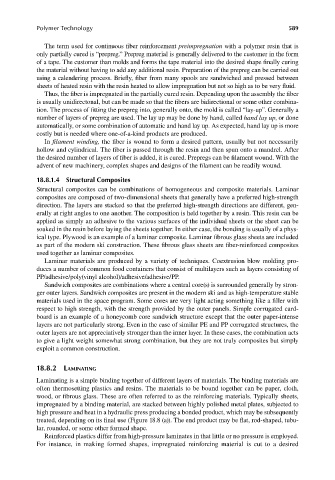Page 626 - Carrahers_Polymer_Chemistry,_Eighth_Edition
P. 626
Polymer Technology 589
The term used for continuous fi ber reinforcement preimpregnation with a polymer resin that is
only partially cured is “prepreg.” Prepreg material is generally delivered to the customer in the form
of a tape. The customer than molds and forms the tape material into the desired shape fi nally curing
the material without having to add any additional resin. Preparation of the prepreg can be carried out
using a calendering process. Briefl y, fiber from many spools are sandwiched and pressed between
sheets of heated resin with the resin heated to allow impregnation but not so high as to be very fl uid.
Thus, the fiber is impregnated in the partially cured resin. Depending upon the assembly the fi ber
is usually unidirectonal, but can be made so that the fibers are bidirectional or some other combina-
tion. The process of fitting the prepreg into, generally onto, the mold is called “lay-up”. Generally a
number of layers of prepreg are used. The lay up may be done by hand, called hand lay up, or done
automatically, or some combination of automatic and hand lay up. As expected, hand lay up is more
costly but is needed where one-of-a-kind products are produced.
In fi lament winding, the fiber is wound to form a desired pattern, usually but not necessarily
hollow and cylindrical. The fiber is passed through the resin and then spun onto a mandrel. After
the desired number of layers of fiber is added, it is cured. Prepregs can be filament wound. With the
advent of new machinery, complex shapes and designs of the filament can be readily wound.
18.8.1.4 Structural Composites
Structural composites can be combinations of homogeneous and composite materials. Laminar
composites are composed of two-dimensional sheets that generally have a preferred high-strength
direction. The layers are stacked so that the preferred high-strength directions are different, gen-
erally at right angles to one another. The composition is held together by a resin. This resin can be
applied as simply an adhesive to the various surfaces of the individual sheets or the sheet can be
soaked in the resin before laying the sheets together. In either case, the bonding is usually of a phys-
ical type. Plywood is an example of a laminar composite. Laminar fibrous glass sheets are included
as part of the modern ski construction. These fibrous glass sheets are fi ber-reinforced composites
used together as laminar composites.
Laminar materials are produced by a variety of techniques. Coextrusion blow molding pro-
duces a number of common food containers that consist of multilayers such as layers consisting of
PP/ adhesive/poly(vinyl alcohol)/adhesive/adhesive/PP.
Sandwich composites are combinations where a central core(s) is surrounded generally by stron-
ger outer layers. Sandwich composites are present in the modern ski and as high-temperature stable
materials used in the space program. Some cores are very light acting something like a fi ller with
respect to high strength, with the strength provided by the outer panels. Simple corrugated card-
board is an example of a honeycomb core sandwich structure except that the outer paper-intense
layers are not particularly strong. Even in the case of similar PE and PP corrugated structures, the
outer layers are not appreciatively stronger than the inner layer. In these cases, the combination acts
to give a light weight somewhat strong combination, but they are not truly composites but simply
exploit a common construction.
18.8.2 LAMINATING
Laminating is a simple binding together of different layers of materials. The binding materials are
often thermosetting plastics and resins. The materials to be bound together can be paper, cloth,
wood, or fibrous glass. These are often referred to as the reinforcing materials. Typically sheets,
impregnated by a binding material, are stacked between highly polished metal plates, subjected to
high pressure and heat in a hydraulic press producing a bonded product, which may be subsequently
treated, depending on its final use (Figure 18.8 (a)). The end product may be flat, rod-shaped, tubu-
lar, rounded, or some other formed shape.
Reinforced plastics differ from high-pressure laminates in that little or no pressure is employed.
For instance, in making formed shapes, impregnated reinforcing material is cut to a desired
9/14/2010 3:43:39 PM
K10478.indb 589
K10478.indb 589 9/14/2010 3:43:39 PM

